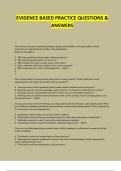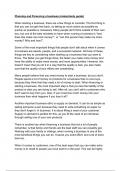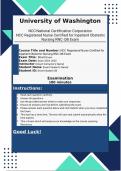Biology A2 Nikhil 13Y Topic 8 Full Notes
TOPIC 8 – Grey Matter
Neurones:
NEURONE STRUCTURE:
A single nerve cell is called a neurone and a nerve is a bundle of neurone
axons covered by a protective layer.
The cell body contains the nucleus of a neurone, and also organelles within
the cytoplasm.
Dendrites direct impulses towards the cell body/nucleus.
Axons conduct electrical impulses away from the cell body.
Schwann Cells compose the myelin sheath, which is a fatty insulating layer
surrounding the axon.
The myelin sheath prevents the flow of ions across the axon
membrane, and hence insulates it. It also helps conduction…
Nodes of Ranvier are the gaps between Schwann cells. This is the ONLY
place that depolarisation can occur. Here, ions can flow and this is how
action potentials are set up.
The impulse jumps from node to node, which allows impulses to be
conducted very quickly. This is why myelinated axons conduct
impulses faster than unmyelinated ones.
This process is known as saltatory conduction.
The speed of conduction is known as conduction velocity.
There are 3 different types of neurones. All neurone types have terminal
branches at one end of the axon, and dendrites at the other. They all have
an axon, and all have Schwann cells:
MOTOR NEURONE:
Appears different from the other two neurones.
Cell body is on the dendrite end of the axon, and dendrites protrude
from the cell body (resembles sunflower).
Also known as effector neurones.
Connects to an effector muscle or gland and transmits impulses from
the CNS to the effector.
SENSORY NEURONE:
Looks similar to a relay neurone, as cell body is in the middle.
Cell body is a protrusion from the axon.
Connected to sensory cells, and transmits impulses to the CNS.
RELAY NEURONE:
Cell body is within the axon and is part of it.
Also known as connector or interneurons.
Dendrites may protrude directly from cell
body, so may resemble motor (spikey body).
,Biology A2 Nikhil 13Y Topic 8 Full Notes
Action Potential:
RESTING:
When a neurone is at rest, and unstimulated, there is a significant difference
in electrical charge, with the outside of the membrane being positive and the
inside being negative.
This is called polarisation.
This p.d. during resting state is around -70mV, called the resting potential.
This resting potential is maintained by sodium-potassium pumps and
potassium channels within a neurone’s cell membrane.
Pumps require ATP as they use active transport to move Na+ and K+
ions. Potassium channels use facilitated diffusion so are passive.
Sodium ions (Na+) are pumped OUT of the neurone. The cell membrane is
impermeable to sodium ions, so they cannot diffuse back in.
This results in an electrochemical sodium ion gradient, with a higher
concentration of sodium ions outside the cell and therefore a more
positive charge.
The sodium-potassium pump also pumps potassium ions (K+) INTO the
neurone, down the electrochemical gradient, however the potassium
channels allow permeability for potassium ions.
Therefore overall, the outside of the cell membrane maintains a net
positive charge, resulting in the resting potential voltage.
STIMULATED:
When neurones are STIMULATED, they become depolarised.
The stimulus/action potential triggers some sodium channels to open, as
sodium and potassium channels are voltage-gated.
The cell membrane becomes more permeable to sodium ions, which
then move into the neurone down their electrochemical gradient.
The inside of the neurone becomes less negative as Na+ ions enter.
Once the threshold is reached (-55mV), more sodium channels open,
causing an increase in the facilitated diffusion of Na+ ions into the cell.
The cell becomes depolarised, meaning the p.d. across the cell
membrane is in equilibrium. Depolarisation.
Following depolarisation, at around +30mV, repolarisation occurs, and
sodium ion channels close, and the potassium ion channels open.
The membrane therefore becomes more permeable to K+ ions.
K+ move out of the cell, down the potassium ion concentration gradient. This
returns back the resting potential (-70mV), as the outside of the cell
becomes increasingly positively charged.
Hyperpolarisation occurs after repolarisation, becuase potassium ion
channels are slow in closing, therefore too many K+ ions diffuse out the cell.
This causes a lower p.d. than the resting potential.
The channels then reset and the sodium-potassium pump returns the
resting potential.
, Biology A2 Nikhil 13Y Topic 8 Full Notes
REFRACTORY PERIOD:
This whole process is the action potential across a neurone.
After an action potential is generated, the neurone cannot be stimulated again
immediately, as the channels are recovering and so can’t open.
This period of recovery is called the refractory period.
This refractory period ensures action potentials do not overlap or interfere
with one another, by acting as a time delay.
Each potential passes as a discrete impulse, and the impulse is
unidirectional.
The magnitude/intensity of the stimulus does not change the size of the
change in p.d. across the membrane.
Instead, the stimulus can determine changes in the frequency of the
action potential.
If the threshold voltage is not reached, then an action potential will not fire.
Synapses:
When an impulse (or action potential) reaches the end of a neurone,
chemicals called neurotransmitters carry the information and communicate
to the next neurone, so that the action potential continues.
This is done via chemicals at a synapse, which is a junction between two
neurones. The gap between the two synapses is called the synaptic cleft.
The presynaptic membrane is the synapse with a large head (swelling),
called the synaptic knob.
The synaptic knob contains synaptic vesicles which are filled with
neurotransmitters, the chemical messengers.
When an action potential reaches the end of a neurone (presynaptic
membrane), it stimulates calcium voltage-gated channels to open at the
presynaptic knob, and calcium ions (Ca2+) diffuse into the presynaptic knob
After the response, they’re actively pumped out of the neurone again.
This calcium ion influx triggers synaptic vesicles in the knob to move
towards the presynaptic membrane.
Exocytosis occurs as the vesicles fuse with the membrane.
The neurotransmitters are then released into the synaptic cleft.
They then diffuse across the synaptic cleft to the postsynaptic
membrane on the other neurone, and bind to specific receptors.
When these neurotransmitters bind, they can trigger sodium channels to
open, and Na+ ions flow into the postsynaptic membrane.
If the threshold is reached, an action potential is
generated.
Receptors are only present on the postsynaptic membrane,
hence impulses are only unidirectional.
After the impulse, the neurotransmitters are removed from the cleft to prevent
a repeated response.














